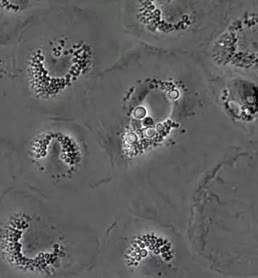 | ||
Vomocytosis is the cellular process by which live organisms that have previously been engulfed by a white blood cell are expelled without being destroyed. Vomocytosis was first reported in 2006 by two groups, working simultaneously in the UK and the USA, based on time-lapse microscopy footage characterising the interaction between macrophages and the human fungal pathogen Cryptococcus neoformans. Subsequently, this process has also been seen with other fungal pathogens such as Candida albicans and Candida krusei. It has also been speculated that the process may be related to the expulsion of bacterial pathogens such as Mycobacterium marinum from host cells. Vomocytosis has been observed in phagocytic cells from mice, humans and birds, as well as being directly observed in zebrafish and indirectly detected (via flow cytometry) in mice.
The mechanism of vomocytosis remains unclear although it is known to be influenced by inflammatory signals and rearrangements of the actin cytoskeleton within the host cell. Different morphologies of vomocytosis have been documented and it is possible that the underlying cellular mechanism may vary between them.
